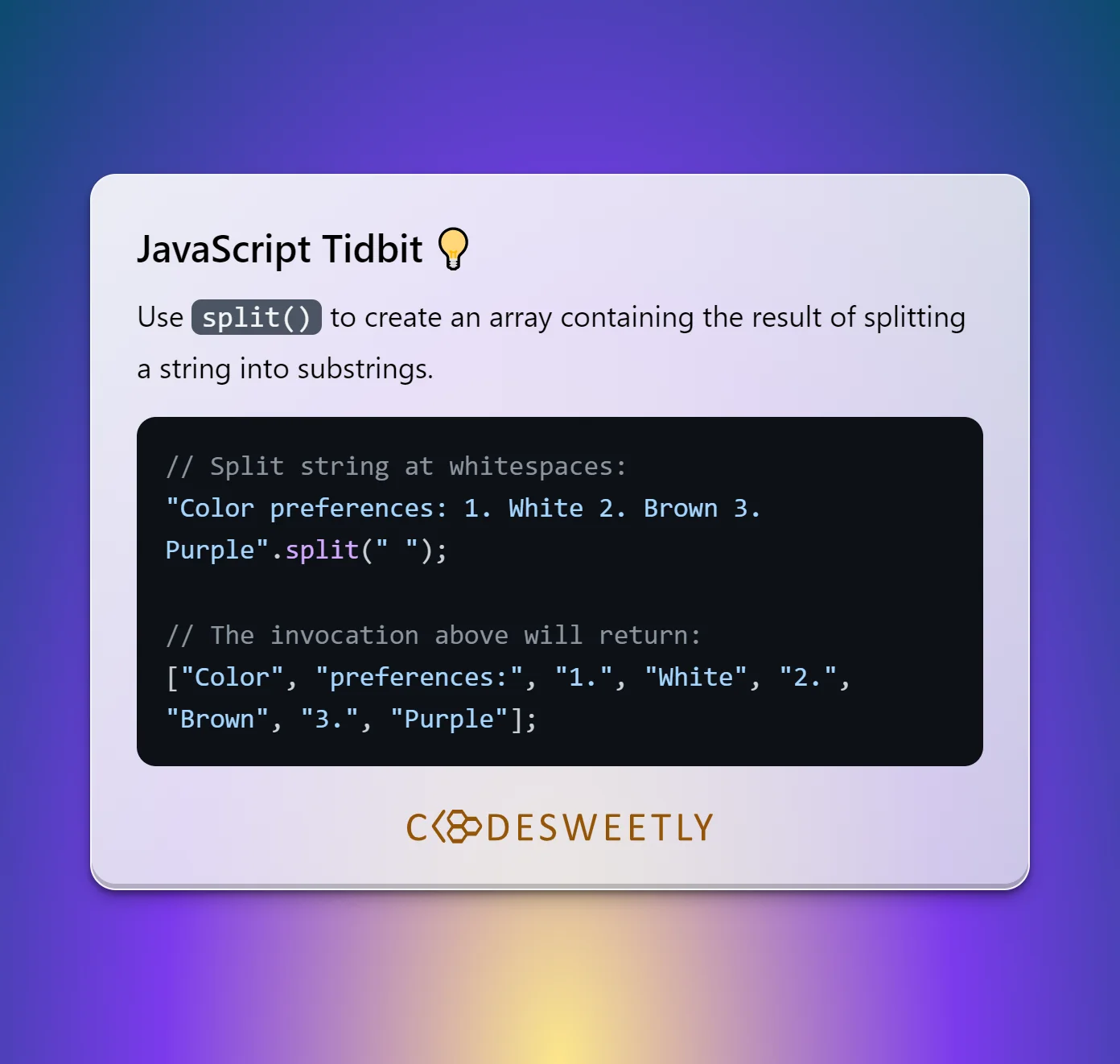split() JavaScript String Method – How to Split a String
Whenever you use split() on a string, the method does the following:
- It splits (divides) the string into substrings.
- It puts the substrings into an array.
- It returns the newly created array—without changing the original string.
split() is sometimes written as String.prototype.split() because it is a method of the String object's prototype property.
Syntax of the split() Method
Here is split()'s syntax:
string.split("separation-point", "array-limit");
The snippet above shows that split() accepts two arguments: a separation-point and an array-limit.
Argument 1: separation-point
A separation-point is the first argument accepted by the split() method. It is an optional argument that specifies the exact position where you want to split the string.
Example 1: Split string at whitespaces
"Color preferences: 1. White 2. Brown 3. Purple".split(" ");
// The invocation above will return:
["Color", "preferences:", "1.", "White", "2.", "Brown", "3.", "Purple"];
The snippet above told the computer to split the calling string at each whitespace character.
You can use any character or regular expression as the separation-point.
Example 2: Split string at each letter o
"Color preferences: 1. White 2. Brown 3. Purple".split("o");
// The invocation above will return:
["C", "l", "r preferences: 1. White 2. Br", "wn 3. Purple"];
Example 3: Split string at each digit character
"Color preferences: 1. White 2. Brown 3. Purple".split(/\d/);
// The invocation above will return:
["Color preferences: ", ". White ", ". Brown ", ". Purple"];
/\d/is a regular expression syntax that is equivalent to numbers zero (0) to nine (9).- Suppose the regular expression contains a capturing group. In that case, the computer will include the matched patterns in the returned array.
Here's an example:
"Color preferences: 1. White 2. Brown 3. Purple".split(/(\d)/);
// The invocation above will return:
["Color preferences: ", "1", ". White ", "2", ". Brown ", "3", ". Purple"];
Example 4: Split string at each hit pattern
"Color preferences: 1. White 2. Brown 3. Purple".split("hit");
// The invocation above will return:
["Color preferences: 1. W", "e 2. Brown 3. Purple"];
Suppose you specify an empty string as the separation point. In that case, the computer will split the string after each character (whitespaces inclusive).
Get creative with your projects
Example 5: Split string after each character
"On the day".split("");
// The invocation above will return:
["O", "n", " ", "t", "h", "e", " ", "d", "a", "y"];
Suppose you omit the separation-point argument. In that case, no split will occur. Therefore, the computer will return an array containing only one element (the unsplit calling string).
Argument 2: array-limit
An array-limit is the second argument accepted by the split() method. It is an optional argument indicating the limit of items the computer should put in the new array.
In other words, once the number of items in the new array equals the array-limit, the computer will ignore the rest of the calling string's characters.
The array-limit argument must be a positive integer.
Example 1: Split string at whitespaces but limit the returned array to one item only
"Color preferences: 1. White 2. Brown 3. Purple".split(" ", 1);
// The invocation above will return:
["Color"];
Example 2: Split string at whitespaces but limit the returned array to two items
"Color preferences: 1. White 2. Brown 3. Purple".split(" ", 2);
// The invocation above will return:
["Color", "preferences:"];
Suppose the array-limit argument is zero (0). In that case, the computer will return an empty array.
Example 3: Split string at whitespaces but limit the returned array to zero items
"Color preferences: 1. White 2. Brown 3. Purple".split(" ", 0);
// The invocation above will return:
[];
Example 4: Split string at each letter o but limit the returned array to two items
"Color preferences: 1. White 2. Brown 3. Purple".split("o", 2);
// The invocation above will return:
["C", "l"];
Important Stuff to Know about split()'s First Argument
When the separation-point argument is an empty string (""), the computer will use UTF-16 code units to split the calling string—not user-perceived characters (grapheme cluster).
Therefore, using an empty string as a separation point argument will destroy surrogate pairs and cause bugs in your application.
For instance, let's use a surrogate character (💟) in a split statement:
"In💟".split("");
// The invocation above will return:
["I", "n", "\ud83d", "\udc9f"];
You can see that split() divided the calling string into four substrings—not three.
split() returned an array of four substrings because the heart decoration character (💟) is a surrogate formed by a combination of the "\ud83d" and "\udc9f" code points.
In other words, split() use UTF-16 code points to divide a string into an array of substrings—which can cause bugs that are difficult to spot.
A better alternative is to use the spread operator to split a string into a list of individual characters.
Here's an example:
[..."In💟"];
// The invocation above will return:
["I", "n", "💟"];
You can see that the spread syntax split the string correctly.
Overview

Use split() to create an array containing the result of splitting a string into substrings.
split() returns an array containing the result of splitting a string into substrings.
Your support matters: Buy me a coffee to support CodeSweetly's mission of simplifying coding concepts.
Join CodeSweetly Newsletter